Archive for the 'Board Game Review' Category
Posted by James (admin) on 2nd October 2010
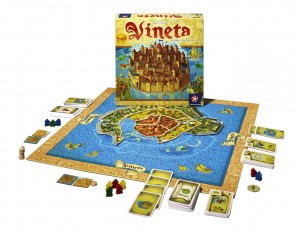 In Vineta, players are Norse gods trying to sink the city of Vineta in order to score points primarily by removing houses from the sunken sections. The game board is made up of nine city sections that fit together to create make a city comprising of 3 rings of 3 areas. Lots of coloured houses are placed on the city areas at the start by the players (usually quite spread out).
In Vineta, players are Norse gods trying to sink the city of Vineta in order to score points primarily by removing houses from the sunken sections. The game board is made up of nine city sections that fit together to create make a city comprising of 3 rings of 3 areas. Lots of coloured houses are placed on the city areas at the start by the players (usually quite spread out).
Each player has a hand of cards and two secret objective tiles – one shows which city area the player will get bonus points for if it is the one area that survives, and the other tile shows which colour of houses they will get bonus points for if any of that colour survive too.
Each round, players take turns playing a card from their hand. Cards fall into two main types – wave cards and special actions. Wave cards have a value of 1 to 4 and, at the end of the round, the city area with the highest wave total will sink. Read the rest of this entry »
Tags: board game news, Board Games, board gaming, Vineta
Posted in Board Game Review, Board Games, Vineta | No Comments »
Posted by James (admin) on 29th September 2010
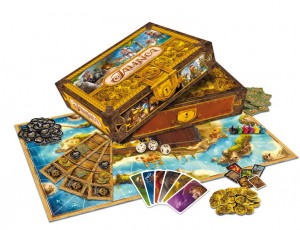 Recently I’ve referred to Jamaica a couple of times (in previews of Sobek and Tikal II) because of its visual design. So, I thought I’d give it a proper review as it’s a really good, light game.
Recently I’ve referred to Jamaica a couple of times (in previews of Sobek and Tikal II) because of its visual design. So, I thought I’d give it a proper review as it’s a really good, light game.
In Jamaica, players are pirate captains who are having a race – the first pirate ship around the island ends the game and ship with the most points wins. Each player has their own deck of actions cards and holds a hand of 3 cards. Each card shows two icons – the left one shows the day-time action and the right one shows the night-time action. The actions are: move forwards, move backwards, take gold, take food, take cannons and each card has a different mix of these action icons.
Each turn, the first player rolls two six-sided dice and allocates one to the day-time and the other to the night-time. These are now fixed for this round and all players will use those results. Read the rest of this entry »
Tags: board game news, Board Games, board gaming, Jamaica
Posted in Board Game Review, Board Games, Jamaica | 6 Comments »
Posted by James (admin) on 21st September 2010
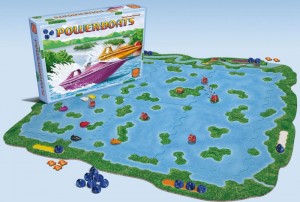 Formula De (now Formula D) is a superb racing game that really brings formula one car racing to life with lots of tricky decisions about whether to risk speed or not, blocking, and speed. So, Powerboats had a tough challenge to live up to.
Formula De (now Formula D) is a superb racing game that really brings formula one car racing to life with lots of tricky decisions about whether to risk speed or not, blocking, and speed. So, Powerboats had a tough challenge to live up to.
The game board consists of 6 double-sided board sections which show hex grids with hexes either full of water or land. The board sections interlock and fit within a frame that holds them in place. The board sections can be rotated and flipped to create a massive variety – one side of the boards is easier than the other as the ratio of water to land is different.
The course of the race is laid out using a start/finish line and 3 marker buoys which are placed on various letters printed on the boards; however, you can place them anywhere you want too to make what you feel is the best course. As you’d expect, the first player to get their boat round each of the buoys (in order and in the correct direction) and cross the finish line wins. Read the rest of this entry »
Tags: board game news, Board Games, board gaming, Powerboats
Posted in Board Game Review, Board Games, Powerboats | No Comments »
Posted by James (admin) on 20th September 2010
 Il Principe is a difficult game to categorise as it involves card management, bidding, area control and role taking. However, rather than delivering a confusing mix of genres, it delivers a tight game which I really enjoyed.
Il Principe is a difficult game to categorise as it involves card management, bidding, area control and role taking. However, rather than delivering a confusing mix of genres, it delivers a tight game which I really enjoyed.
Players are building cities and institutions in Italy to earn victory points (VPs). At the start of each round, players receive 5 cash and 4 cards – the cards come in 5 colours each representing a different city institution (town hall, university, etc.). The players keep 2 cards and the rejected cards are combined and auctioned off colour-by-colour. After the auctions, a player can either (a) use cards and cash to build a city, or (b) place as many cards face-up in front of them of one colour showing control over the 5 different institutions.
There are 10 role cards (5 major & 5 minor in each colour). The player with the most face-up cards of each colour gets the matching-coloured major role uses the role’s benefit, e.g. the player with the most face-up green cards gets the Banker role card which earns them 2 extra cash. Read the rest of this entry »
Tags: board game news, Board Games, board gaming, Il Principe
Posted in Board Game Review, Board Games, Il Principe | No Comments »
Posted by James (admin) on 17th September 2010
 Zombie Dice is a dice-rolling, push-your-luck game where players are zombies trying to be the first to eat 13 brains. The game consists purely of 13 special dice whose faces show either footprints, shotgun blasts or brains. The dice are one of 3 different dice types: The 6 green dice have more brains and few shotgun blasts, the 4 red dice have more shotgun blasts and fewer brains, and the 4 yellow dice are in between the two.
Zombie Dice is a dice-rolling, push-your-luck game where players are zombies trying to be the first to eat 13 brains. The game consists purely of 13 special dice whose faces show either footprints, shotgun blasts or brains. The dice are one of 3 different dice types: The 6 green dice have more brains and few shotgun blasts, the 4 red dice have more shotgun blasts and fewer brains, and the 4 yellow dice are in between the two.
On their turn, a player takes 3 dice at random from the card tube and rolls them. Any shotgun blast and brain results are set aside. If the player has any footstep dice remaining they can take more dice at random from the tube to make a total of 3 dice and roll again. The player can stop at any time and the amount of brains they have accumulated is added to their score. If a player has no footstep results (i.e. they just roll brains and blasts), then their turn automatically ends. However, if the player ever has 3 shotgun blasts then their turn is over and they lose any brains they rolled during that turn. First player to eat 13 brains wins. Read the rest of this entry »
Tags: board game news, Board Games, board gaming, Zombie Dice
Posted in Board Game Review, Board Games | No Comments »
Posted by James (admin) on 11th September 2010
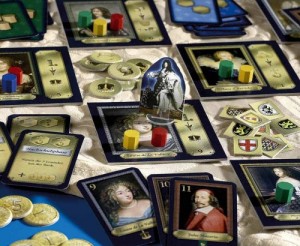 Louis XIV is mostly a worker placement game but it’s quite unusual. First of all, there’s no board; instead, there are 12 mini-boards laid out corner-to-corner in a square grid – this makes it easy to flip over any of the mini-boards but it also leaves spaces where various tokens get placed too. Over 4 rounds, players try to earn as many victory points as possible. Players can earn many VPs by fulfilling their mission cards which are completed by collecting the power chips shown on each card. There are 4 types of power chip as well as one type that counts as any type.
Louis XIV is mostly a worker placement game but it’s quite unusual. First of all, there’s no board; instead, there are 12 mini-boards laid out corner-to-corner in a square grid – this makes it easy to flip over any of the mini-boards but it also leaves spaces where various tokens get placed too. Over 4 rounds, players try to earn as many victory points as possible. Players can earn many VPs by fulfilling their mission cards which are completed by collecting the power chips shown on each card. There are 4 types of power chip as well as one type that counts as any type.
Each round, players receive 5 cards – each card corresponds to one of the 12 mini-boards. Each turn, players can play one of their cards and place up to 3 of their cubes (workers) from their supply onto the mini-board that matches their card. Also, they can move any of the newly placed cubes onto an adjoining mini-board so long as they leave at least one cube behind and do not spread in two different directions at once from the same mini-board. As players only have a limited amount of cubes, they can use their turn to add some cubes to their supply instead of placing. Players discard the last card left in their hand so usually get 4 turns. Read the rest of this entry »
Tags: board game news, Board Games, board gaming, Louis XIV
Posted in Board Game Review, Board Games, Louis XIV | No Comments »
Posted by James (admin) on 11th September 2010
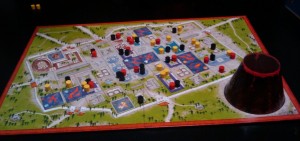 The Downfall of Pompeii is a light and fast game where players place their people in the buildings of Pompeii and then score points for each one that escapes the city after the volcano erupts. In the first phase of the game, players take turns playing building cards to place their people in the building that matches their card. Each building has a fixed number of spaces for people and, if a building is full, then the player can place their people in any building with spaces. When the AD79 card is drawn, the placement gets faster because if a person is placed in a building that already has occupants, the player adds that many extra people elsewhere on the board too. During this time, a player may draw an Omen card which means they get to throw one of their opponent’s people into the card volcano. Read the rest of this entry »
The Downfall of Pompeii is a light and fast game where players place their people in the buildings of Pompeii and then score points for each one that escapes the city after the volcano erupts. In the first phase of the game, players take turns playing building cards to place their people in the building that matches their card. Each building has a fixed number of spaces for people and, if a building is full, then the player can place their people in any building with spaces. When the AD79 card is drawn, the placement gets faster because if a person is placed in a building that already has occupants, the player adds that many extra people elsewhere on the board too. During this time, a player may draw an Omen card which means they get to throw one of their opponent’s people into the card volcano. Read the rest of this entry »
Tags: board game news, Board Games, board gaming, The Downfall of Pompeii
Posted in Board Game Review, Board Games, Downfall of Pompeii | No Comments »
Posted by James (admin) on 9th September 2010
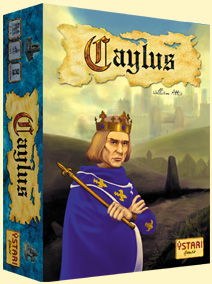 I had played Caylus: Magna Carta before (the smaller, card-based version of Caylus) but not the original big game so I was looking forwards to playing this.
I had played Caylus: Magna Carta before (the smaller, card-based version of Caylus) but not the original big game so I was looking forwards to playing this.
During the game, players place their workers on various buildings so they can generate resources and cash which they can then use to build further buildings and generate victory points. First, players take turns placing their workers on the available buildings. Only one player can use each building during a round, so timing your placement of your workers can be agonising (in a good way) because you always want to place your workers in multiple places at once (always a good sign in a worker placement game) before someone else does. When all players have passed, the buildings get resolved in order (moving along the road that leads out of the castle). Some buildings generate resources (food, wood, stone, cloth, gold), some generate cash, and some have special effects like allowing a player to build a new building, changing the turn order, allowing a player to buy a resource for cash, trade gold for victory points, and so on. Read the rest of this entry »
Tags: board game news, Board Games, board gaming, Caylus
Posted in Board Game Review, Board Games, Caylus | 2 Comments »
Posted by James (admin) on 8th September 2010
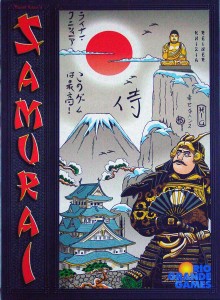 In Reiner Knizia’s classic game, players take turns placing hexagonal tiles from their hand onto a map of Japan where some of the hexes (villages, towns and cities) contain one or more of the 3 types of markers (helmets, rice fields, buddhas). When a location containing one or more markers is surrounded by tiles (sea areas don’t need to contain tiles), the tile strengths of each player are added up and the player with the greatest relevant strength wins the relevant marker. Many tiles’ strength only counts towards capturing one of the 3 types of markers but a few (like the Samurai) count towards all types.
In Reiner Knizia’s classic game, players take turns placing hexagonal tiles from their hand onto a map of Japan where some of the hexes (villages, towns and cities) contain one or more of the 3 types of markers (helmets, rice fields, buddhas). When a location containing one or more markers is surrounded by tiles (sea areas don’t need to contain tiles), the tile strengths of each player are added up and the player with the greatest relevant strength wins the relevant marker. Many tiles’ strength only counts towards capturing one of the 3 types of markers but a few (like the Samurai) count towards all types.
For example, a hex on the coast containing a Buddha maker has the following tiles around it: Red 2 buddha, Red 2 samurai, Yellow 4 helmet, Yellow 1 Samurai, Green 3 buddha. As the other hex around this location is a sea hex, the village is surrounded. In this case, Red wins the Buddha because they have a total of 4 towards capturing buddhas. Green’s total of 3 isn’t enough, and neither is Yellow’s total of 1 because their helmet tiles doesn’t count towards capturing buddhas.
Read the rest of this entry »
Tags: board game news, Board Games, board gaming, Knizia, Samurai
Posted in Board Game Review, Board Games, Samurai | 1 Comment »
Posted by James (admin) on 28th August 2010
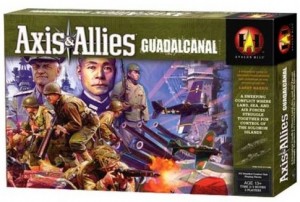 [Note: After posting this review, someone let me know that Hasbro issued some errata and the reinforcement points should have been twice as many, i.e. 10 + 4 per island. That would have made a big difference as we could have bought a lot more reinforcements. Hasbro’s web site says you can play it either way (with double reinforcement points or without) so this is a review of the game without that ammended rule as we played it using the rules as stated in the box. Please keep this in mind when you read the review and I’ll comment more on it at the end.]
[Note: After posting this review, someone let me know that Hasbro issued some errata and the reinforcement points should have been twice as many, i.e. 10 + 4 per island. That would have made a big difference as we could have bought a lot more reinforcements. Hasbro’s web site says you can play it either way (with double reinforcement points or without) so this is a review of the game without that ammended rule as we played it using the rules as stated in the box. Please keep this in mind when you read the review and I’ll comment more on it at the end.]
Axis & Allies: Guadalcanal is one of the three 2-player Axis & Allies games – the others being D-Day and Battle of the Bulge. Each game has completely different rules to the others and all have different rules compared to the main Axis & Allies game too. Earlier this year, my friend Matt and I decided to start playing some games that are connected to their anniversaries so we played A&A: D-Day on June 6th. As I like A&A: D-Day and Battle of the Bulge, I picked up a second-hand copy of Guadalcanal to play in August (anniversary of the start of the Guadalcanal conflict).
The Guadalcanal conflict was a series of battles during World War II which lasted many months where both sides fought over a group of tactically important islands in the Pacific. So, the board shows 6 main islands (land zones) and the sea around them is segmented into zones, plus players have a home base zone each too. Both players have land forces (infantry, artillery, anti-air), air forces (fighters, bombers) and sea forces (transports, destroyers, cruisers, submarines, aircraft carriers, battleships). The islands have spaces on them where one or two airfields can be built. Read the rest of this entry »
Tags: board game news, Board Games, board gaming
Posted in Axis & Allies: Guadalcanal, Board Game Review, Board Games | 6 Comments »
 In Vineta, players are Norse gods trying to sink the city of Vineta in order to score points primarily by removing houses from the sunken sections. The game board is made up of nine city sections that fit together to create make a city comprising of 3 rings of 3 areas. Lots of coloured houses are placed on the city areas at the start by the players (usually quite spread out).
In Vineta, players are Norse gods trying to sink the city of Vineta in order to score points primarily by removing houses from the sunken sections. The game board is made up of nine city sections that fit together to create make a city comprising of 3 rings of 3 areas. Lots of coloured houses are placed on the city areas at the start by the players (usually quite spread out).









